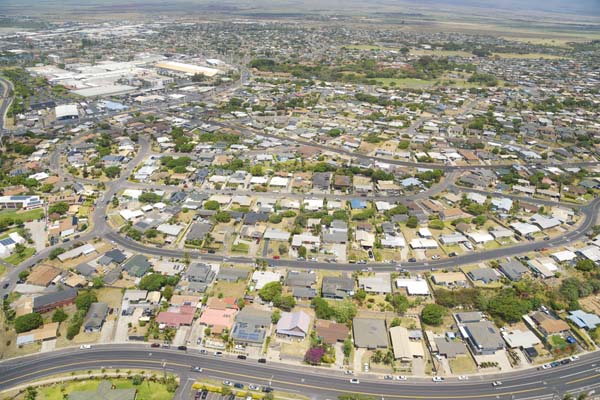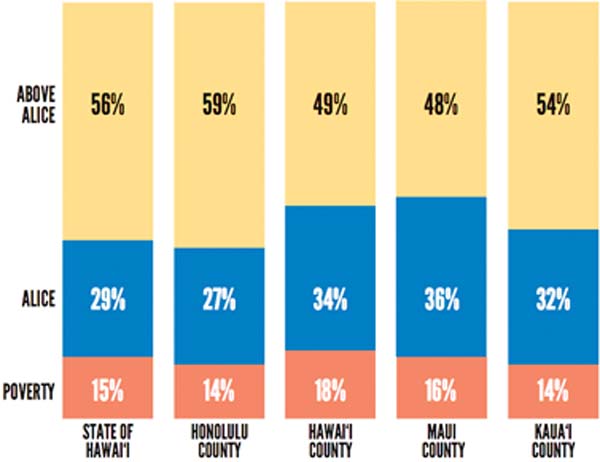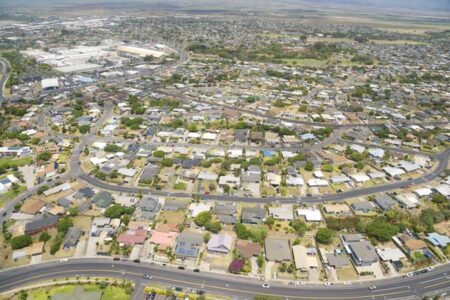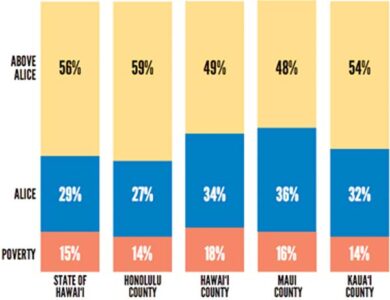52% of Maui County homes live below ALICE threshold
Report: More Hawaii families falling below basic cost of living, federal poverty lines

More than half of households in Maui County are estimated to be living below the ALICE threshold, meaning they are below both the basic cost of living and federal poverty lines, according to a recent report. The Maui News / MATTHEW THAYER photo
Maui County has seen the largest increase in poverty in the state since 2018, according to a recent report that noted a growing trend in Hawaii families slipping below both the basic cost of living and federal poverty lines.
The percentage of households in Maui County living below the federal poverty line rose from 6 percent in 2018 to 16 percent in 2022, “the most significant jump of any other county,” said Kimo Carvalho, vice president of community impact for Aloha United Way.
“Since the Great Recession of 2008, we’ve been really trying to call attention to the fact that it really just takes one emergency to tip someone over into poverty, and that tipping point for us was the pandemic,” Carvalho said during a news conference Tuesday as the nonprofit and its partners released the 2022 study of ALICE — Asset Limited, Income Constrained, Employed households.
The study, described as one of the largest recent surveys of its kind in Hawaii, aims to track financial hardship and comes at a time when residents are facing sharp inflation and the possibility of another U.S. recession.
According to the study, which drew 2,391 responses, more Hawaii households have fallen below the ALICE threshold, the average income needed to afford the household survival budget. Costs vary by family and location, but the average household survival budget in Hawaii is just over $35,000 for a single adult and more than $100,000 for a family of two adults and two small children.

Percentage of ALICE Households by County: This graph from Aloha United Way’s 2022 “ALICE in Hawaii” report shows the percentage of households in each county living below the ALICE threshold, which is the level of income needed for a household survival budget of just over $35,000 for a single person and more than $100,000 for a family of four. Graphic courtesy Aloha United Way
In 2018, 42 percent of households were living below the ALICE threshold; in 2022, this increased to 44 percent, or about 634,000 individuals based on current population estimates, Carvalho said.
Statewide, 56 percent of residents are living above the ALICE threshold, while 29 percent are considered in the ALICE category (below the basic cost of living but above the federal poverty line) and 15 percent are below the federal poverty line.
Oahu fares better than the statewide average, with 59 percent of households living above the ALICE threshold, 27 percent in the ALICE category and 14 percent below the federal poverty line.
But in Neighbor Island counties, the percentage of ALICE households is greater.
Maui County leads the state with 36 percent of households in the ALICE category and 16 percent below the poverty line. Another 48 percent are living above the ALICE threshold, the lowest in the state.
In Hawaii County, 34 percent of households are in the ALICE category and 18 percent are below the federal poverty line, while 49 percent live above the ALICE threshold.
In Kauai County, 32 percent are in the ALICE category and 14 percent are below the federal poverty line, while 54 percent live above the ALICE threshold.
“The significant news to share with everyone, however, is that while more households and individuals fell below the ALICE threshold, what is more disappointing is that many of those who were already in ALICE or above the ALICE threshold have actually fallen into poverty. It’s about a 66 percent increase since 2018 in the wrong direction,” Carvalho said, pointing out that the state’s poverty rate has gone from 9 percent in 2018 to 15 percent in 2022.
In Hawaii, an income below the federal poverty line comes out to $15,630 for a single-person household and $31,920 for a four-person household.
Most households living below the ALICE threshold (84 percent) have a combined annual income of $75,000 or less, which is roughly equivalent to two full-time wage-earners receiving $18 an hour.
“What this tells us is $18 an hour really is the baseline,” Carvalho said. “If you are a household earning less than $75,000, the tools that we’re deploying to really help mobilize our population are not gonna work as effectively.”
During the most recent legislative session, state lawmakers passed a bill that would raise the minimum wage to $18 by 2028, starting with an increase to $12 in October. Prior to that, the minimum wage was $10.10.
The study also showed that three in four Hawaii households are carrying debt, and one in three below the ALICE threshold owe “more than is manageable.”
“The majority of our Hawaii residents are actually carrying a lot of debt,” Carvalho said. “Debt is often an early indicator into downward spirals. In our line of work it’s often an opportunity to intervene.”
Maui County residents listed difficulty paying off debts such as car payments or credit card bills as one of their top challenges in the wake of the pandemic, followed by difficulty paying housing expenses and mental health issues.
The study also found disparities between ethnicities, as Native Hawaiian and Filipino residents are more likely to be living below the ALICE threshold.
Households below the threshold are also more likely to have children, to live in larger households of three or more occupants, to have lower levels of education and to be working, but with inconsistent work opportunities.
“The report shows a growing divide in Hawaii between those living comfortably and those trying to survive financially, especially affecting Hawaiian and Pacific Islander households, female-led households, and households with children,” the report says. “This trend of more residents falling below the ALICE Threshold predates the pandemic and will only grow if we continue with the status quo.”
While the report is not intended to make specific policy recommendations, it pointed out that the findings demonstrate a clear need for action in the following key areas:
• New safety net supports for ALICE households impacted by short-term setbacks.
• Bridge programs that transition households through potential benefit cliffs and support economic mobility.
• Policies to increase homeownership and stable housing, and prioritize local residents.
• More widespread, equitable access to financial services and credit, action to discourage predatory lenders and programs to address unmanageable levels of debt.
• Support for asset-building, savings, financial planning and education programs.
• Investments to address the growing mental health crisis, so that any resident who requests services can quickly receive them.
• Robust education-to-workforce pipeline to prepare residents for higher wage jobs here in Hawaii.
To view the full 2022 report, visit www.auw.org/alice-initiative.
* Colleen Uechi can be reached at cuechi@mauinews.com.
- More than half of households in Maui County are estimated to be living below the ALICE threshold, meaning they are below both the basic cost of living and federal poverty lines, according to a recent report. The Maui News / MATTHEW THAYER photo
- Percentage of ALICE Households by County: This graph from Aloha United Way’s 2022 “ALICE in Hawaii” report shows the percentage of households in each county living below the ALICE threshold, which is the level of income needed for a household survival budget of just over $35,000 for a single person and more than $100,000 for a family of four. Graphic courtesy Aloha United Way


